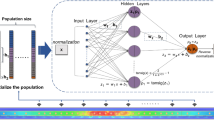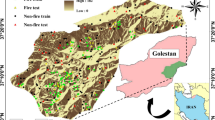Abstract
With the increasing impacts of global climate change, forest fires pose an increasingly severe threat to ecosystems and human societies. This study delves into the imperative realm of forest fire risk prediction, which is crucial in escalating threats exacerbated by global climate change. This study significantly improves the accuracy and robustness of the predictions by introducing a hybrid model integrating the backpropagation neural network (BPNN) and the genetic algorithm (GA). Compared to traditional neural networks, the genetic algorithm-backpropagation neural network (GA-BP) model exhibits significant advantages in weight optimization, overcoming limitations of BP networks such as slow learning rates and susceptibility to local optima. The experimental results demonstrate that the GA-BP model, under various combinations of neuron counts and activation functions, improves accuracy by nearly 10% and reduces loss values by almost 47%. These outcomes emphasize the effectiveness of the GA-BP model in forest fire risk prediction, providing valuable insights and a robust framework for proactive risk management and ecosystem preservation amidst escalating threats of severe forest fires.






Similar content being viewed by others
Explore related subjects
Discover the latest articles, news and stories from top researchers in related subjects.Data Availability
Not applicable
Materials Availability
Not applicable
Code Availability
Not applicable
References
Tang Z, Zhang T, Wu L, Ren S, Cai S (2024) Knowledge mapping for fire risk assessment: A scientometric analysis based on vosviewer and citespace. Fire 7:23
Halofsky JE, Peterson DL, Harvey BJ (2020) Changing wildfire, changing forests: the effects of climate change on fire regimes and vegetation in the pacific northwest, usa. Fire Eco 16:1–26
Jacks E, Hockenberry H (2013) An overview of noaa’s fire weather, climate, and air quality forecast services. Remote Sens Model Appl Wildland Fires 41–54
Huang X et al (2023) Smoke-weather interaction affects extreme wildfires in diverse coastal regions. Science 379:457–461
Gao B et al (2024) Prediction and driving factors of forest fire occurrence in jilin province, china. J Forest Res 35:21
Masinda M M, Li F, Qi L, Sun L, Hu T (2022) Forest fire risk estimation in a typical temperate forest in northeastern china using the canadian forest fire weather index: case study in autumn 2019 and 2020. Natural hazards 1–17
Li X, Zhao G, Yu X, Yu Q (2014) A comparison of forest fire indices for predicting fire risk in contrasting climates in china. Natural hazards 70:1339–1356
Zhang F et al (2023) Forest fire driving factors and fire risk zoning based on an optimal parameter logistic regression model: a case study of the liangshan yi autonomous prefecture, china. Fire 6:336
Chen W et al (2021) Wildfire risk assessment of transmission-line corridors based on naïve bayes network and remote sensing data. Sensors 21:634
Wang K et al (2023) Cloud-fog-based approach for smart wildfire monitoring. Simul Model Pract Theory 127:102791
Liu S, Xu J (2022) Wildfire, protected areas and forest ownership: The case of china. Land Use Policy 122:106372
Yue W, Ren C, Liang Y, Lin X, Liang J (2023) Method of wildfire risk assessment in consideration of land-use types: A case study in central china. Forests 14:1393
Hong H, et al. (2018) Applying genetic algorithms to set the optimal combination of forest fire related variables and model forest fire susceptibility based on data mining models. the case of dayu county, china. Sci Total Environ 630:1044–1056
Zhang S, Gao D, Lin H, Sun Q (2019) Wildfire detection using sound spectrum analysis based on the internet of things. Sensors 19:5093
Lin H, Liu X, Wang X, Liu Y (2018) A fuzzy inference and big data analysis algorithm for the prediction of forest fire based on rechargeable wireless sensor networks. Sustain Comput: Inf Syst 18:101–111
Abram NJ et al (2021) Connections of climate change and variability to large and extreme forest fires in southeast australia. Commun Earth Environ 2:1–17
Reddy CS et al (2019) Identification and characterization of spatio-temporal hotspots of forest fires in south asia. Environ Monitor Assess 191:1–17
Su Z, Zheng L, Luo S, Tigabu M, Guo F (2021) Modeling wildfire drivers in chinese tropical forest ecosystems using global logistic regression and geographically weighted logistic regression. Natural hazards 108:1317–1345
Hernandez-Leal P, Arbelo M, Gonzalez-Calvo A (2006) Fire risk assessment using satellite data. Adv Space Res 37:741–746
Mohajane M et al (2021) Application of remote sensing and machine learning algorithms for forest fire mapping in a mediterranean area. Ecologic Indic 129:107869
Peng B, Zhang J, Xing J, Liu J (2021) Online moisture measurement of dead fine fuel on the forest floor using near-infrared reflectometry. Rev Sci Inst 92
Casal-Guisande M, Bouza-Rodríguez J-B, Cerqueiro-Pequeño J, Comesaña-Campos A (2023) Design and conceptual development of a novel hybrid intelligent decision support system applied towards the prevention and early detection of forest fires. Forests 14:172
Costa-Saura JM, Balaguer-Beser Á, Ruiz LA, Pardo-Pascual JE, Soriano-Sancho JL (2021) Empirical models for spatio-temporal live fuel moisture content estimation in mixed mediterranean vegetation areas using sentinel-2 indices and meteorological data. Remote Sens 13:3726
Fitriany AA, Flatau PJ, Khoirunurrofik K, Riama NF (2021) Assessment on the use of meteorological and social media information for forest fire detection and prediction in riau, indonesia. Sustain 13:11188
Lin X, Li Z, Chen W, Sun X, Gao D (2023) Forest fire prediction based on long-and short-term time-series network. Forests 14:778
Zhang Y, Tian L (2021) Dynamic changes in moisture content and applicability analysis of a typical litter prediction model in yunnan province. Peer J 9:e12206
Zhang S, Pan M (2024) Advancing forest-fire management: Exploring sensor networks, data mining techniques, and svm algorithm for prediction. Prevent Treat Nat Disaster 3
Boroujeni S P H, et al. (2024) A comprehensive survey of research towards ai-enabled unmanned aerial systems in pre-, active-, and post-wildfire management. Inf Fus 102369
Zheng Z et al (2020) Predicting forest fire risk based on mining rules with ant-miner algorithm in cloud-rich areas. Ecologic Indic 118:106772
Freitas W et al (2020) Influence of fire foci on forest cover in the atlantic forest in rio de janeiro, brazil. Ecologic Indic 115:106340
Yin S, Wang X, Guo M, Santoso H, Guan H (2020) The abnormal change of air quality and air pollutants induced by the forest fire in sumatra and borneo in 2015. Atmos Res 243:105027
El-Kenawy E S M, Khodadadi N, Mirjalili S, Abdelhamid A A, Eid M M, Ibrahim A (2024) Greylag goose optimization: nature-inspired optimization algorithm. Exp Syst Appl 238:122147
El-Kenawy ESM, Rizk FH, Zaki AM et al (2024) Football optimization algorithm (fboa): A novel metaheuristic inspired by team strategy dynamics. J Art Intell Metaheuristics 8:21–38
Yadav RK (2020) Pso-ga based hybrid with adam optimization for ann training with application in medical diagnosis. Cogn Syst Res 64:191–199
Nisar K, Sabir Z, Zahoor Raja MA et al (2021) Numerical study of the environmental and economic system through the computational heuristic based on artificial neural networks. Sensors 21:6567
Gonçalves C B, Souza J R, Fernandes H (2022) Cnn optimization using surrogate evolutionary algorithm for breast cancer detection using infrared images 84–89
Pravina R, Uthayakumar H, Sivasamy A (2023) Hybrid approach based on response surface methodology and artificial neural networks coupled with genetic algorithm (rsm-ga-ann) for the prediction and optimization for the photodegradation of dye using nano zno anchored glass fiber under solar light irradiation. J Taiwan Inst Chem Eng 153:105248
Li Y, Feng Z, Chen S, Zhao Z, Wang F (2020) Application of the artificial neural network and support vector machines in forest fire prediction in the guangxi autonomous region, china. Disc Dyna Nat Soc 2020:1–14
Rumelhart DE, Hinton GE, Williams RJ (1986) Learn Represent Back-Propagat Errors. Nature 323:533–536
Acknowledgements
The author thanks independent reviewers for essential comments, which were used with gratitude for the correction and extension of the article. The author thanks the editor and the editorial office with gratitude for the editorial corrections that improved the final text of the article.
Funding
This work received no external funding.
Author information
Authors and Affiliations
Contributions
M.P. and S.Z. conceptualized the study and wrote the original draft. M.P. performed the numerical simulations. S.Z. was responsible for data curation and reviewing and editing the manuscript.
Corresponding author
Ethics declarations
Competing Interests
The authors declare no competing interests.
Ethics Approval and Consent to Participate
Not applicable
Consent for publication
Not applicable
Additional information
Communicated by: Hassan Babaie.
Publisher's Note
Springer Nature remains neutral with regard to jurisdictional claims in published maps and institutional affiliations.
Rights and permissions
Springer Nature or its licensor (e.g. a society or other partner) holds exclusive rights to this article under a publishing agreement with the author(s) or other rightsholder(s); author self-archiving of the accepted manuscript version of this article is solely governed by the terms of such publishing agreement and applicable law.
About this article
Cite this article
Zhang, S., Pan, M. Climate change impacts on wildfire risk indices forecast based on an improved genetic neural network algorithm: a case study of Guangxi, China. Earth Sci Inform 18, 297 (2025). https://doi.org/10.1007/s12145-025-01769-1
Received:
Accepted:
Published:
DOI: https://doi.org/10.1007/s12145-025-01769-1




